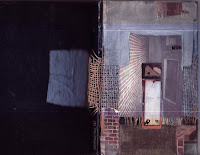Preparing a syllabus for "Breaking the Boundaries" intensive workshop I thought about how to give examples of an art process to students, because before you "break the boundaries" you have to create them or at least find them. For that you have to discover your own creative process. The Creative Habit by Twyla Tharp was useful, but I wanted something hands-on. So I realized that I have all those books of mine. .. Hard cover with often more writing than paintings they are a process of my thinking. I picked up on eof my first American sketch book, dated 08/91-10/92. It says SKETCHBOOK 5A. I am not sure what 5A stands for.
Looking through the book I discovered an interesting clear transition from Russian suprematism to sexual expressionism. And I saw through the pages how naturally it happened... There is a poem (in Russian) that I am trying to write all the way through the book. It also illustrates this transition from clear geometrical structure to childish uncontrolled desire and physical expression.
So, here comes this clear, geometrical composition standing between black square itself, theater set and geometrical minimalism, touching all three.
Further in the book, you can find drawings that are transitional between geometrical decorative ala 1930's designs with curve lines and words often as a part of the drawing:
Words inside the drawing on the lower right are "Russia with Bad Luck".
Unfinished Russian poem on the left says: Inside the blue turned up side down square of of a human noise a crowd of old points of view has been walking inside the crowd through rivers, gardens and bridges...

With a poetry about transition, motion and descriptive organic shapes straight and edgy lines turn around, bind, connect softly... circles replace squares.




No comments:
Post a Comment